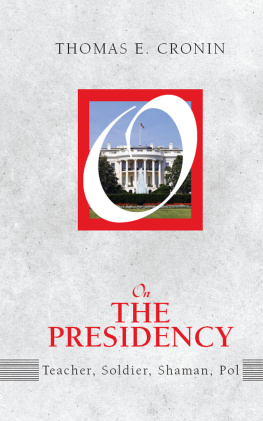Table of Contents
Introduction
Its usually a bad idea to begin a book by saying what it is not. But in this case, it really needs to be said. This book is not about the American presidentswho was the best, who was the worst, who was the fattest, who had the most children, who was the only bachelor. You will get none of that here. (Okay, the fattest was William Howard Taft, at 332 pounds. But thats it.)
This is a book not about the American presidents, but about the American presidency. It is a history of the creation and the development of the office, the institution.
The American presidency comes with only the thinnest of instruction manuals, Article II of the U.S. Constitution, which consists of just 1,046 words as originally written. The framers of the Constitution supplied a loose outline and left the rest to those who would actually occupy the office. As a result, the American presidency remains a work in progress. Thats what makes the subject so fascinating. It has a past, a present, and a futurewhich we can only imagine.
Now a word about sex. (Or, at any rate, gender.)
The 2008 election season brought to American history three historic firsts. For the first time in our nations political journey, a woman, Hillary Rodham Clinton, had a serious prospect of becoming president. She came in second in the Democratic primaries to Barack Obama, the first African American nominated by a major party as its presidential candidate and, as it turned out, after 220 years of white presidents, the first African American elected to the office. Obama and his vice presidential running mate, Sen. Joe Biden, were opposed by Republican Sen. John McCain and his running mate, Alaska governor Sarah Palinonly the second woman (Democrat Geraldine Ferraro was the first, in 1984) in U.S. history to receive a major-party nomination for the vice presidency.
It is inevitable that women will serve as American presidents. But since it has not happened yetsince every American president so far has been a manI have used the masculine pronoun exclusively throughout this book in all generic references to the president. When will history compel a change in this grammatical convention? Stick around for subsequent editions.
How to Use This Book
This book is divided into seven parts:
Part 1, Presidential Precedents and Prototypes, explores American government before there were presidents, why the founding fathers decided that there should be presidents, and how they drew up the outlines for the presidency. We will look at the constitutional specifications for the office and how the first six presidents modeled the presidency. This part also offers a chapter on the vice presidency and its progress from a largely ceremonial office to a powerful, even controversial, feature of the executive branch.
Part 2, Uncommon Common Men, begins with Andrew Jackson, who radically redefined the relationship between the chief executive and the people, building the first peoples presidency. This part traces the mixed legacy of Jackson, especially how his presidency affected the next eight as the nation marched toward civil war. We end with the uncommonest common man of all, Abraham Lincoln, who restructured the presidency in a heroic effort to restore the Union and the American democracy he believed was the last best hope of earth.
Part 3, Retreat and Advance, shows how the Congress, recoiling from the extraordinary power President Lincoln had amassed for his office, acted to reclaim government for the legislative branch. The struggle began dramatically with impeachment of Lincolns crude, obstinate, and unpopular successor, Andrew Johnson, and continued variously through the last three decades of the nineteenth century, leaving the presidency a much-diminished office.
Part 4, The Progressive Presidency, presents the reemergence of presidential power at the start of the twentieth century, beginning with the spectacular presidency of Theodore Roosevelt, whose progressivism was diminished, along with the presidency itself, by his handpicked successor, William Howard Taft, only to be raised to an even loftier height by Woodrow Wilson, the first president to make the Oval Office a center of world leadership.
Part 5, From Normalcy to the Personal Presidency, narrates the headlong retreat from the progressive and internationalist presidency created by Roosevelt and Wilson in a return to the normalcy of the passive party-line presidencies of Warren G. Harding and Calvin Coolidge. The onset of the Great Depression at the start of the Hoover administration revealed the inadequacy of the status quo approach to the executive office and made way for a new invention, the personal presidency of Franklin Delano Roosevelt. After dimming somewhatbut only somewhatin the presidencies of Harry S. Truman and Dwight D. Eisenhower, both of whom made unique contributions to the office, the personal presidency reemerged vigorously in the unfinished presidency of John F. Kennedy.
Part 6, The Imperial Presidency, investigates how Democrat Lyndon Johnson and Republican Richard Nixon pushed the constitutional envelope to create what critical historians have dubbed the imperial presidency. This part explores the consequences of pushing the imperial presidency too far (Nixon is the only American president to resign his office) and how his successors, Republican Gerald Ford and Democrat Jimmy Carterthe first outsider presidenteach struggled to dismantle presidential imperialism and rehabilitate the tarnished office.
Part 7, The CEO Presidency, starts with the election of another outsider president, Ronald Reagan, who embarked on a mission to get big government off our backs, modeling the presidency on the private-sector corporate CEO. A controversial visionary, Reagan was succeeded by his vice president, George H. W. Bush, who introduced a vigorous diplomatic presidency. Lacking his predecessors charisma, Bush was defeated for reelection by yet another outsider, Democrat Bill Clinton, who struggled to overcome increasing partisan conflict by designing a centrist presidency. Despite a troubled second term, Clinton bequeathed to his successor, George W. Bush, a country enjoying peace and prosperity. The final chapter of this part shows how Bush expanded executive authority, yet assumed inadequate personal responsibility for the consequences as the nation became mired in an unpopular war and was assailed by a massive economic meltdown. The 2008 election brought into the Oval Office its first African American occupant, Democrat Barack Obama.
At the back of the book, youll find a chronological list of the presidents and vice presidents, a summary of presidential elections, and suggestions for further reading.
Extras
Throughout the book, youll find the following four types of sidebars:
What They Said
These are memorable statements from presidents, vice presidents, and others.











